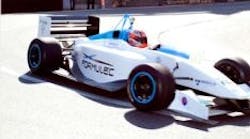By 2014, you may be able to watch regular races run with open-wheel-type cars that are powered only by electric motors. But the racing community still seems to have doubts about the practicality of the idea.
The Fédération Internationale de l'Automobile (FIA), which runs the Formula 1 race series, licensed the commercial rights for what's called the Formula E Championship to a consortium dubbed Formula E Holdings Ltd. Now details are emerging about how FEH expects to run races with fields populated exclusively with electric vehicles. It recently bought 42 electric race cars for the series from a newly formed company called Spark Racing Technology (SRT). McLaren Electronic Systems will design and construct the powertrain for the first Formula E car.
Unlike ordinary Formula 1 and Indy car racing, Formula E will be an "open" series, meaning that anyone who follows FIA technical regulations will be able to make Formula E cars. This is in contrast Formula 1 and Indy where only a few manufacturers make race car chassis.
The plan is for Formula e races to take place in urban settings analogous to that of the Monaco Grand Prix. FEH says it has already received interest from a large number of cities to host the "E-Prix." It looks as though Rio de Janeiro will be the site of the first race. FEH hopes to have 20 teams compete in each of these races.
The first electric Formula car was built by a French consortium of companies dubbed Formulec. FEH acquired the Formulec technology and wants it to serve as a basis for the new Spark cars and for other potentially interested car makers. Formulec cars run on lithium batteries and their specs include a top speed of 250 km/hr, an ability to go from 0 to 100 km/hr in three seconds, and lap times close to that of Formula 3 cars.
The only problem is that the cars are good for just a 20-minute race on a single charge and take about 1.5 hours to charge up. This limitation has led to a competition format that has elicited hoots from some in the racing community: Races will only be about 40 minutes long and will call for a pit stop in which the driver hops out of one car and into a second fully charged vehicle to finish the race.
That means each racing team will need to have two cars ready to race for each competition, a proposition that will be expensive for aspiring competitors. "So just who is going to pay for all this?" said an editorial in Racecar Engineering magazine, a Formula 1 racing industry publication in the UK. "I think perhaps while the overall goal of Formula E makes sense, the execution of it hasn't been properly thought out. In its current form, it'll be far too expensive and it lacks sustainability," the publication continued.
And of course, the envisioned racing format means the race may not go to the fastest car, but rather to the team having a driver able to slither out from one car and into the other in the shortest time.
Racecar Engineering Magazine: www.racecar-engineering.com
Formulec: www.formulec.org
FIA: www.fia.com
